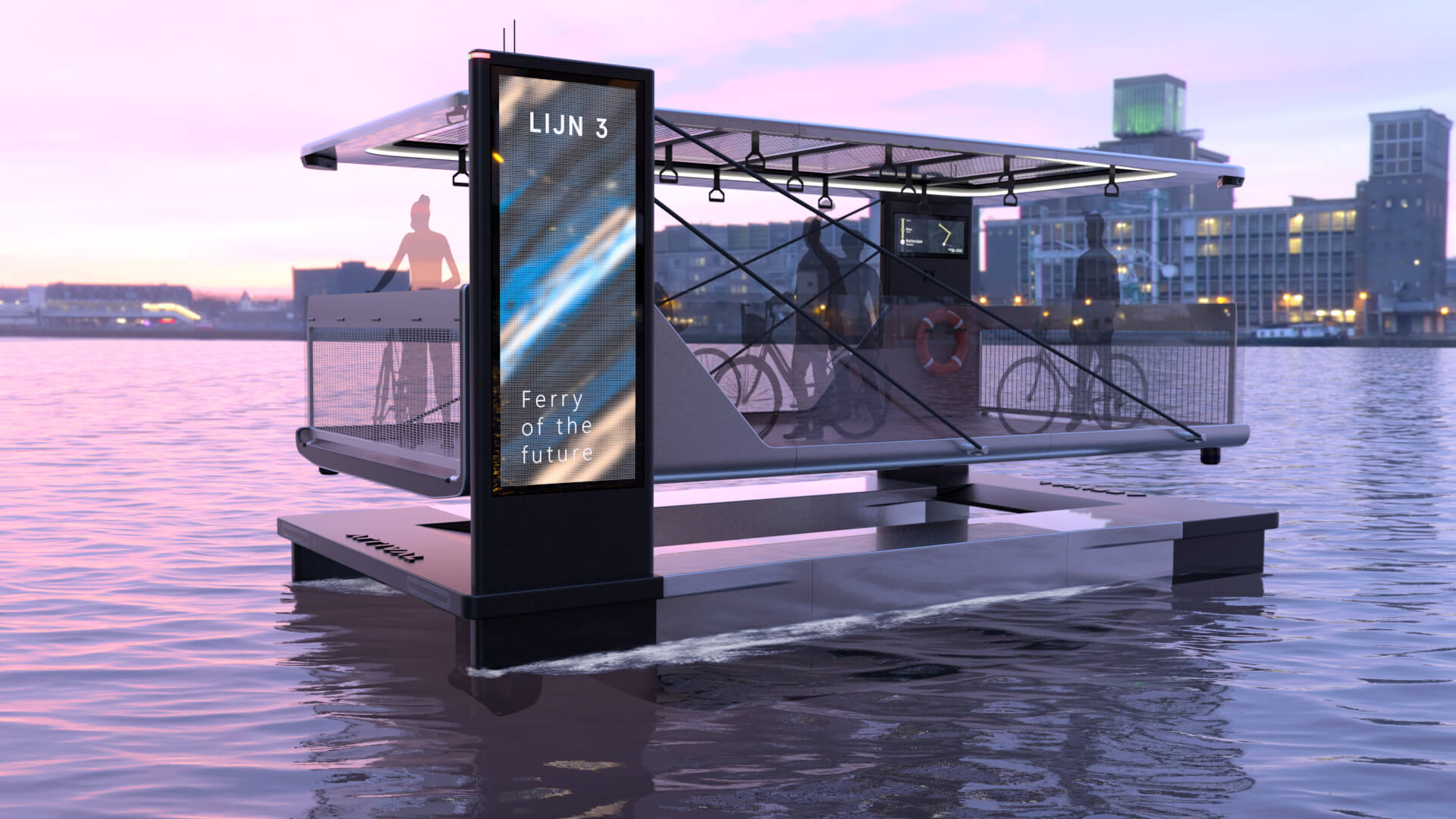Arrival Ferry Concept


- Case Designing the Arrival Ferry Concept
- Client Arrival
- Industry Mobility
Rotterdam, met zijn unieke geografische stadsinrichting, is een stad die wordt opgesplitst door de Maas. Deze scheiding zorgt voor aanzienlijke mobiliteitsuitdagingen, vooral voor bewoners van voormalige havengebieden die tot woongebieden zijn her-ontwikkeld. Door de op de auto gerichte infrastructuur blijft woon-werkverkeer met duurzame middelen zoals de fiets of het openbaar vervoer moeilijk, waardoor de bereikbaarheid van werk en scholen in de hele stad beperkt blijft. Traditionele oplossingen, zoals bruggen en veerboten, zijn duur en het bestaande openbaar vervoer heeft moeite om deze kloven efficiënt te overbruggen.

Visie en projectdoelen
De visie achter het FERRY-concept was om de Rotterdamse waterwegen te transformeren van barrières in verbindingen, waardoor gelijke kansen voor alle burgers ontstaan. Het doel van dit project was het conceptualiseren van een netwerk van autonome, modulaire en duurzame watertaxi’s die de noord- en zuidzijde van de stad zouden overbruggen. De belangrijkste doelen waren het verbeteren van de toegankelijkheid, het bevorderen van duurzaam transport en het creëren van een flexibel shuttle-systeem dat zich kon aanpassen aan het veranderende stedelijke landschap van Rotterdam.

Onderzoek doen om inzichten te verzamelen
Onze onderzoeksfase omvatte een diepe duik in de woon-werkpatronen en behoeften van de inwoners van Rotterdam. Enquêtes en interviews onthulden de beperkingen van het bestaande openbaar vervoer en de behoefte aan snellere, directere routes. We onderzochten ook het vracht- en personenverkeer op de rivier en potentiële aanleglocaties, om routes te optimaliseren voor efficiënt reizen. Deze inzichten onderstreepten de behoefte aan een schaalbare en milieuvriendelijke oplossing die de reistijden kon verkorten en de toegang tot belangrijke gebieden aan de overkant van de rivier kon verbeteren.
Inzichten vertalen in ontwerpcriteria
Op basis van ons onderzoek stelden we de belangrijkste criteria op voor het FERRY-concept. De oplossing moest modulair zijn om schaalbaarheid en aanpasbaarheid mogelijk te maken, met een minimale impact op het milieu van de rivieroevers. We gaven ook prioriteit aan duurzaamheid, met elektrische voortstuwing aangedreven door zonnepanelen en lokale microfabricage voor een lage CO2-voetafdruk. Het ontwerp voorzag in een pendelcapaciteit van tenminste 10 passagiers met fietsen, om tegemoet te komen aan veelvoorkomende woon-werkbehoeften. Bovendien zou het systeem AI-gestuurd zijn, zodat in realtime kan worden gereageerd op piekreistijden en locaties met een grote vraag.

Ontwikkelen: Prototypes verkennen en scenario’s testen
In de conceptfase schetsten we mogelijke prototypes, waarbij we ons concentreerden op modulaire constructies en autonome werking. In testscenario’s werd onderzocht hoe de FERRY om kon gaan met verschillende rivieromstandigheden, aanmeervereisten en passagiersstromen. Het ontwerp omvatte ook de Vision Cockpit, die de passagiers navigatie-informatie en updates verschafte om de gebruikerservaring te verbeteren. De AI-mogelijkheden van het systeem werden in kaart gebracht om ervoor te zorgen dat het systeem zich dynamisch kon aanpassen aan de vraag, zodat de wachttijd bij elke aanlegplaats maximaal vijf minuten zou bedragen.
De impact van het concept in beeld brengen
Hoewel het FERRY-systeem nog een concept is, wordt het gezien als een transformerende oplossing voor het Rotterdamse transportlandschap. Het concept verwacht dat autonome pendeldiensten op zonne-energie de reistijden aanzienlijk kunnen verkorten, de toegankelijkheid van de stad kunnen vergroten en de duurzaamheidsdoelstellingen van Rotterdam kunnen ondersteunen. Modulaire dokken zouden gemakkelijk verplaatst kunnen worden, zodat aan veranderende eisen kan worden voldaan en een zeer aanpasbare vervoersoptie ontstaat. Deze visie sluit aan bij MODYN’s streven om innovatieve mobiliteitsoplossingen te creëren die zowel duurzaam als aanpasbaar zijn.

Verwachte resultaten
Als het FERRY-concept wordt gerealiseerd, kan het een revolutie teweegbrengen in het woon-werkverkeer in Rotterdam door duurzaam reizen over de Maas toegankelijker te maken. Dit systeem zou het gebruik van fietsen waarschijnlijk doen toenemen, de afhankelijkheid van auto’s verminderen en de inspanningen van de stad op het gebied van CO2-reductie ondersteunen. Met een adaptief AI-systeem zou de FERRY de routes verder kunnen optimaliseren op basis van real-time gegevens, waardoor de efficiëntie en gebruikerstevredenheid na verloop van tijd zouden toenemen.
Reflectie en toekomstige overwegingen
Het FERRY-concept is een voorbeeld van het potentieel van modulair en autonoom vervoer over water in stedelijke omgevingen. In de toekomst zou het concept kunnen worden uitgebreid met opties voor vrachtvervoer, waardoor er minder vrachtwagens nodig zijn in het stadscentrum. Naarmate de technologie zich verder ontwikkelt, met name op het gebied van AI en duurzame materialen, zou de FERRY nog responsiever en meer aanpasbaard kunnen worden en nieuwe mogelijkheden kunnen bieden voor stedelijke mobiliteit en connectiviteit. In de toekomst kan ook worden onderzocht hoe dit concept kan worden toegepast op andere steden met vergelijkbare geografische uitdagingen.








